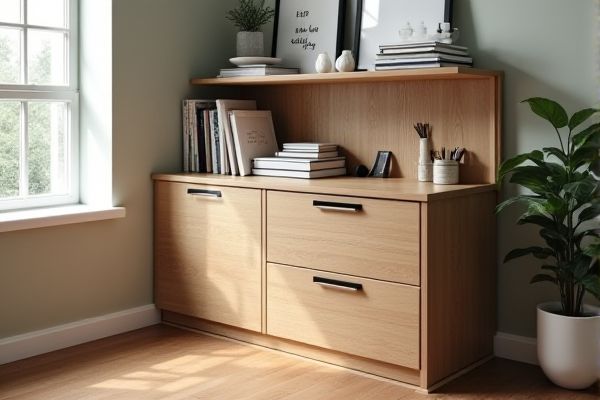
Open file cabinets provide quick and easy access to documents by eliminating drawer fronts, ideal for frequently used files, while lateral file cabinets offer wider drawers that extend horizontally, maximizing storage space and supporting more organized file categorization. Explore the rest of the article to determine which cabinet style best suits your office needs and enhances your filing system efficiency.
Table of Comparison
| Feature | Open File Cabinet | Lateral File Cabinet |
|---|---|---|
| Design | Vertical, open front for easy access | Horizontal, wide drawers for spacious storage |
| Storage Capacity | Limited to vertical hanging files | Holds more files with larger drawer space |
| Space Efficiency | Compact footprint, suits small offices | Requires wider space, ideal for large offices |
| File Accessibility | Quick access to files with open design | Files spread horizontally, easy browsing |
| Security | Usually less secure, often without locks | Often includes locking mechanisms for security |
| Durability | Generally lighter and less sturdy | Robust construction, more durable |
| Cost | Typically lower price point | Higher cost due to size and features |
Overview of Open File Cabinets and Lateral File Cabinets
Open file cabinets feature front-to-back drawer organization ideal for hanging files and quick access, while lateral file cabinets offer side-to-side drawers maximizing storage in wider spaces. Lateral cabinets typically provide larger surface areas for workspace and are better suited for office layouts requiring both file storage and accessibility. Your choice depends on space constraints and preferred filing system efficiency.
Design Differences Between Open and Lateral File Cabinets
Open file cabinets feature a vertical design with exposed filing spaces, allowing quick access to documents but limited privacy and protection from dust. Lateral file cabinets have wider drawers that extend horizontally, providing more storage capacity and better organization with a sleek, enclosed design that protects files. The choice between them depends on space availability and the need for accessibility versus file security.
Storage Capacity Comparison
Open file cabinets typically offer easier access to documents but have less storage capacity due to their open design and fewer enclosed compartments. Lateral file cabinets maximize storage capacity by utilizing wider drawers, allowing you to store more files horizontally and efficiently organize large volumes of documents. Your choice depends on whether you prioritize accessibility or maximum storage space for your filing needs.
Accessibility and Organization Features
Open file cabinets provide quick access to documents with their exposed drawers and easy visibility, ideal for frequently used files. Lateral file cabinets offer broader drawer space for organized categorization, supporting hanging files and reducing clutter in wider office layouts. Both designs enhance workspace efficiency, but choice depends on prioritizing immediate accessibility or detailed organization.
Space Efficiency in the Workplace
Open file cabinets optimize space efficiency by providing easy access to frequently used documents without the need for drawer clearance, making them ideal for compact work environments. Lateral file cabinets maximize horizontal storage capacity, accommodating larger files and reducing vertical space usage, which suits wider office layouts with limited floor area. Choosing between the two depends on the specific workspace dimensions and document organization needs to enhance overall office ergonomics and productivity.
Security and Privacy Considerations
Open file cabinets offer limited security due to their exposed design, making confidential documents vulnerable to unauthorized access or theft. Lateral file cabinets typically come with locking mechanisms, providing enhanced privacy and protection for sensitive information in office environments. Choosing lateral file cabinets significantly improves data security by restricting physical access to important files and reducing the risk of information breaches.
Durability and Material Options
Open file cabinets typically offer moderate durability with materials like metal or plastic, making them suitable for lighter use and easy access to documents. Lateral file cabinets are known for their robust construction, often crafted from heavy-duty steel or high-quality wood, providing superior durability for long-term storage. Your choice depends on the need for strength and material preferences, with lateral cabinets excelling in sturdiness and open cabinets prioritizing accessibility.
Aesthetics and Office Integration
Open file cabinets offer a minimalist design that enhances office aesthetics by providing easy access to documents while contributing to an open, uncluttered workspace. Lateral file cabinets have a more substantial presence with wider drawers, often complementing modern office furniture and providing a sleek, streamlined look. Your choice depends on your office style preferences and how seamlessly you want the filing system to blend with existing decor.
Cost Analysis: Open vs. Lateral File Cabinets
Open file cabinets generally cost less upfront due to simpler construction and fewer materials, making them a budget-friendly choice for basic storage needs. Lateral file cabinets, while more expensive, offer greater storage capacity and enhanced durability, justifying the higher investment for long-term use in busy office settings. Evaluating the total cost of ownership, including maintenance and space efficiency, often favors lateral cabinets in professional environments despite the steeper initial price.
Choosing the Right File Cabinet for Your Needs
Open file cabinets offer easy access and quick visibility for frequently used documents, making them ideal for fast-paced office environments. Lateral file cabinets provide ample horizontal storage space, fitting wider documents and larger volumes while optimizing space along walls. Selecting the right file cabinet depends on your office layout, document size, and frequency of access to ensure efficient organization and retrieval.
 homyna.com
homyna.com